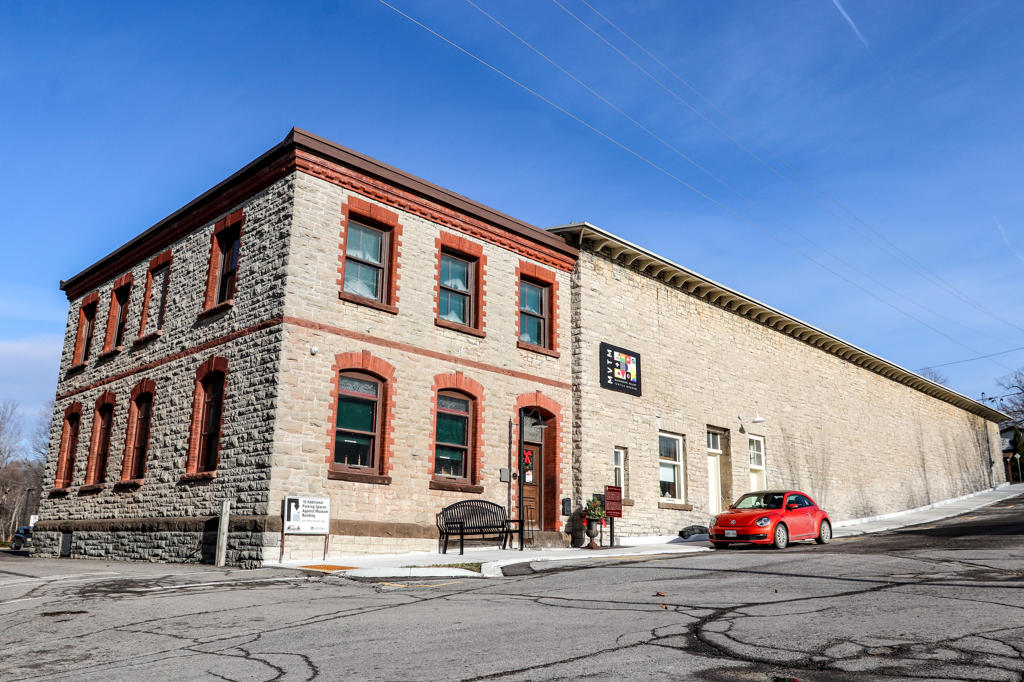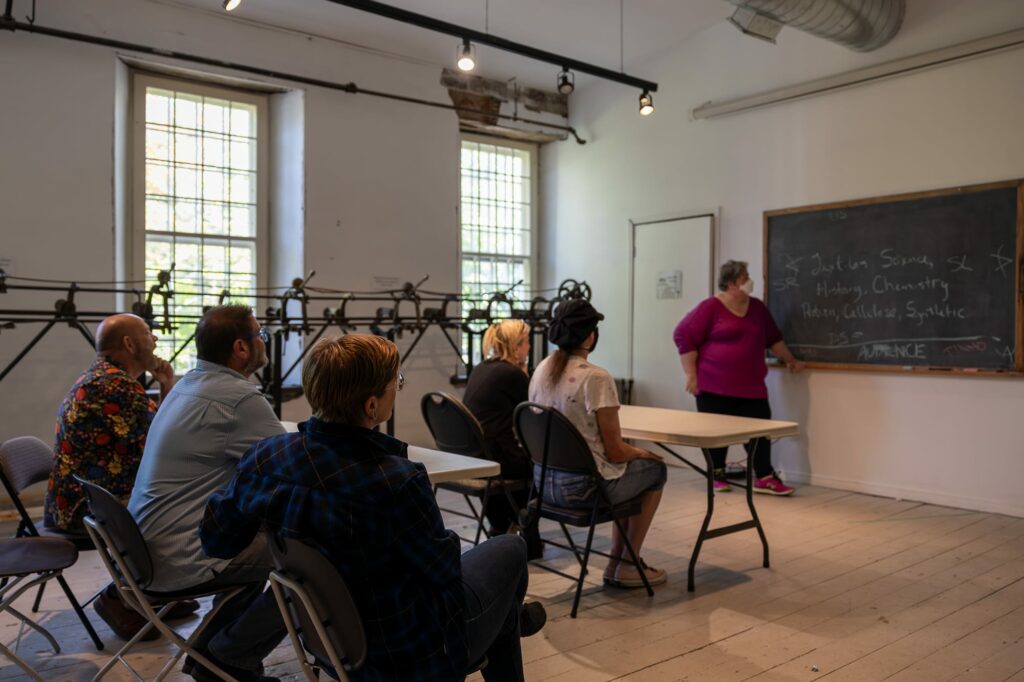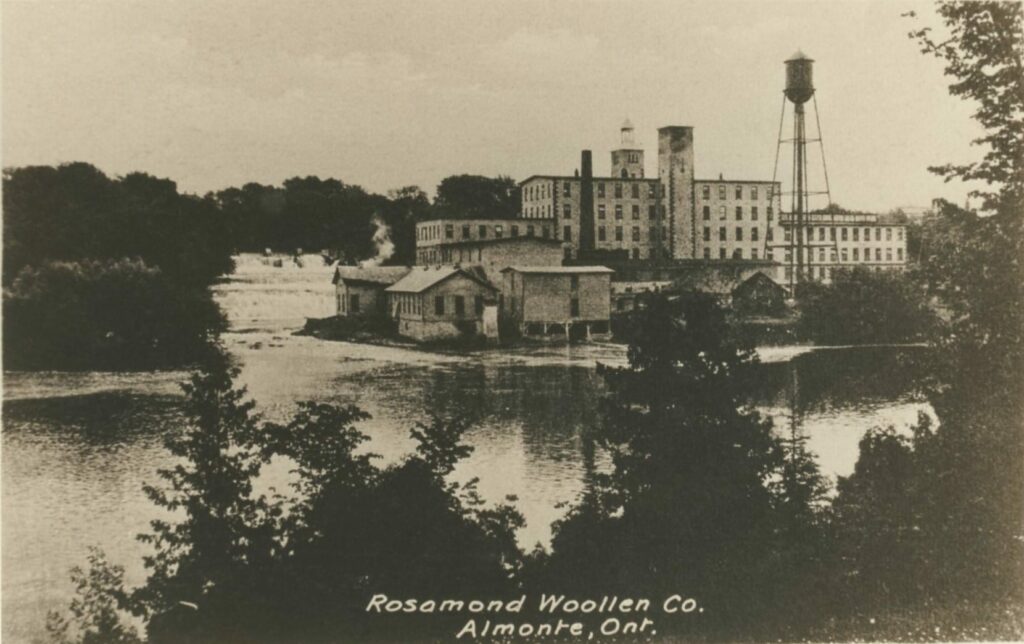
The Mississippi Valley Textile Museum houses three venue spaces: the Norah Rosamond Hughes Gallery, the Wool Hall Gallery and the Millworkers’ Learning Centre.
The spaces feature original architectural details such as large twenty-eight pane windows, conserved plaster work, exposed stone walls and wood beams and columns.
Our Spaces

Norah Rosamond Hughes Gallery
The Norah Rosamond Hughes Gallery typically houses temporary exhibits. This large space with its high, industrial ceilings is named for Norah Rosamond Hughes, daughter of James Rosamond Jr. Located on the first floor of the museum, the space features original preserved stone and plaster walls and exposed wood elements.

Wool Hall Gallery
The Wool Hall Gallery houses the permanent exhibit. This large space with its high, industrial ceilings is named for the tradition of local woolen mills and for the permanent exhibit showcasing the industrial woolen process and the life of millworkers. Located on the second floor of the museum, the space features original preserved stone and plaster walls and exposed wood elements.

Mill Workers Learning Centre
Are you looking for a unique space to hold your event? Our Millworkers’ Learning Centre has hosted art workshops, choir groups, conference meetings and photoshoots.
Named the “Mill Workers Learning Centre”, the addition of this light filled space was made possible through funds from the Dolgoy and Kostash Families.
History of our building

The Mississippi Valley Textile Museum (MVTM) is located in the annex of the former Rosamond Woolen Company in Almonte, Ontario. Constructed in 1867 this National Historic Site of Canada now features a blend of the old and new, all related to the history of the Mississippi Valley and the textile industry.
The Mississippi Valley Textile Museum represents the combined vision, dedication and hard work of many volunteers, staff and community members.
Timeline: History of the Museum
1965
- Idea of a textile museum in Almonte first discussed by the chair of the Ontario Historical Society.
1980
- Celebration of Almonte’s centennial leads to greater awareness of Almonte and area’s industrial heritage.
- Committee formed to plan celebrations. (John Dunn (chair), Jim Groenewald (Municipal Councillor), Gerry Wheatley, Mary-Lou and John Souter).
- Committee publishes the booklet Faces and Places 1880 – 1980.
1982
- Committee formed to explore creating a textile museum (Members: Stan Morton, Jack Boyce, Jack Collie, John Dunn, Gerry Wheatley, and Herb Pragnell).
- Committee objectives: to preserve the history of the textile industry and to develop tourism.
- Committee receives funding from Ontario Heritage for a feasibility study.
- Commonwealth Historic Resource Management appointed to carry out a feasibility study under the direction of Dr. Harold Kalman. A group tours textile mills and museums in New England (Herb Pragnell, Gerry Wheatley, Jack Collie, Dr. Kalman and three reps from the National Capital Commission).
1983
- Feasibility study completed and favours creating a textile museum in Almonte.
1985
- Museum’s visitor centre opens in Almonte Old Post Office.
- Museum applies for and receives incorporation and non-profit status as the Mississippi Valley Textile Museum.
1986
- Visitor centre moves to 72 Mill Street, Almonte.
- Museum committee appoints Diane Duncan as Manager.
- Committee members Gerry Wheatley, Marilyn Snedden and Dawn Leduc conduct initial research into textile industry.
1987
- Diane Duncan moves to another job and Jo Cavellero is hired as Manager.
- Rosamond No. 1 Mill and Victoria Woolen Mill are vacant and considered as potential permanent homes for the Museum. Museum of Science and Technology in Ottawa is consulted and recommends the Annex (offices and warehouse) of the Rosamond No. 1 Mill because it has large floor areas on two floors and ground level access to both.
- Rosamond No. 1 Mill is purchased by R. Burkhart, who plans to turn the main mill building into condominiums.
- Annex is purchased by Museum Board with $100,000 grant from Ontario Heritage matched by a $100,000 mortgage from the Town of Almonte.
1988
- Museum’s new building in great disrepair, and warehouse roof must be replaced.
- Ontario Heritage requires a development plan, which is produced by the Cornerstone Planning Group and serves as a base for building improvements and alterations.
- Board develops first fundraising plan and carries out a fundraising program to raise funds for the new roof.
1989
- Museum operations move into Rosamond Woolen Company Annex.
1990
- New warehouse roof installed, and Museum opens to the public.
- First exhibit showcases the Almonte Gazette printing press.
- Window and door repairs carried out, led by volunteer Robert Connolly at a cost of $10,000. Hardwood floors and woodwork restored by the Heritage Carpentry Program of Algonquin College, Perth.
- June 2, 1990 – The Mississippi Valley Textile Museum’s building is declared a National Historic Site.
- Jo Cavellero retires.
1991
- Mary Lettner is hired as Museum’s first official Curator.
- Building has no furnaces or air-conditioning units and no working plumbing. Space heaters used in winter and fans in summer, and neighbouring home used for a toilet and sink. No access between offices and warehouse.
- Mary Lettner begins a rotation of summer textile exhibitions.
1992
- The Friends of the Mississippi Valley Textile Museum established as Museum’s main fundraising body.
1993
- Friends hold first fashion show fundraiser – an annual fundraiser for almost 20 years.
1994
- Two natural gas furnaces installed for office portion of the building by Carleton Refrigeration and Heating (one for the first floor and one for the second floor).
1995
- Volunteers cut doorway from offices into warehouse portion of the building.
- Stairway constructed by Algonquin College’s Heritage Carpentry program, Perth.
- Volunteers construct Museum’s kitchen with funds from the Friends.
- Five gravel parking spaces created against back of Museum building with the help from the Town and Thomas Cavanagh Construction.
- Lanark County Museum Association is established as a support network.
- First Fibrefest fundraiser held in Museum’s lower gallery
1998
- Front half of floor in the lower gallery replaced with new wood with funds from the Hughes family (Rosamond Family descendants).
- Museum agrees to name the gallery space the “Norah Rosamond Hughes Gallery.”
1999
- Algonquin College Applied Museum Studies Student Michael Rikley and his teacher Mark Alliston volunteer to install an exhibit of works by artist Kristin Ferig.
- Michael Rikley hired as summer student.
2002
- Museum receives $25,000 from the Ontario Trillium Foundation to help attract tourists and tell the story of the area’s contribution to the Canadian textile industry
2003
- Museum receives $10,000 from the Ontario Trillium Foundation to collaborate with the West Carleton Fibre Guild to host a major exhibition of hand weaving and spinning.
- Mary Lettner retires, and Town of Mississippi Mills agrees to provide $35,000 annually to hire a replacement.
2004
- Kelly Baatnes hired as successor.
2005
- Museum receives $9,300 from the Museum Assistance Program (MAP) for a building-needs assessment. Assessment is prepared by Commonwealth Historic Resources Management of Perth.
- First project includes restoring the foundations, redirecting storm drains, installing a vapour barrier around foundation, and installing a sump pit and sump pump under the back of first floor gallery.
- Museum signs five-year agreement with Algonquin College’s Heritage Stone Masonry Program to re-point the north side of the building. (Note: There was no mortar left on the north side of the warehouse building. Students replaced mortar in a section of that wall each year for five years and replaced two to three limestone sills each year.)
2006
- Volunteers remove back half of floor in lower gallery. Funds secured from Hughes Family ($10,000) and from Valley Heartland ($10,000) to replace back half of floor with concrete.
2007
- July 1, 2007 – Michael Rikley-Lancaster is hired as Executive Director/Curator (ED/C).
- ED/C works with the Province of Ontario to increase the Community Museum Operating Grant (CMOG) from $3,000 to $16,050.
- Museum receives in kind contribution from the Town of Mississippi Mills to pave the street around the museum.
- ED/C and Board develop a five-year building restoration and renovation plan using the 2005 Building Needs Assessment document prepared by Commonwealth Historic Resources Management of Perth.
2008
- Museum obtains $15,000 from the Ontario Trillium Foundation, $36,098 from Parks Canada’s National Historic Sites Cost Sharing Program, and $18,500 from community donations to install drywall, track lighting, and insulation in the Wool Hall Gallery ceiling (second floor).
- Mary Lettner passes away.
- Matthew Moxley and Felicity Maxwell hired as summer students. Ms. Maxwell produces essay on step-by-step processing in an industrial woolen mill.
- Partnership with Algonquin College’s Applied Museum Studies Program is created by ED/C to work with graduating students to research and design two new exhibitions: A history exhibit in the Wool Hall Gallery (based on Ms. Maxwell’s research) and recreation and interpretation of the original President’s and financial office.
2009
- Funds received from MAP ($18,000) for a multi-year project to catalogue the Museum’s library and artifact collection. Alexandra Blades hired to catalogue the 2,000 library holdings and 3,000 artifacts. Project includes purchase of the database Past Perfect. All research and artifact holdings documented, photographed, and entered into Past Perfect.
- Museum’s library dedicated to the memory of former curator Mary Lettner and named the “Mary Lettner Textile Research Centre.”
2010
- Alexandra Blades moves onto another job from holding the Collections Assistant position.
- The Town of Mississippi Mills agrees to raise operational dollars to the Museum by the annual cost of living increase.
- Matthew Moxley hired as Collections Assistant to complete cataloging the research and artifact collections.
- Museum is rebranded with new logo at a cost of $1,100.
2011
- Town of Mississippi Mills funded the museum $37,856 towards museum operations, reflecting COI.
- Grant of $5,200 received from the Ontario Trillium Foundation for installation of a monitored security alarm, flood detection and fire safety system.
- Funds raised ($14,700) to allow Algonquin College Applied Museum Studies students to work with ED/C and construct the exhibit “Fabric of a Small Town” in the Wool Hall Gallery.
- Fabric of a Small Town exhibit opens.
- Funds obtained from Enabling Accessibility Fund ($32,690) to install an accessible ramp at Museum’s rear main entrance and a new accessible washroom on first floor, as well as upgrading the second-floor washroom to make it accessible. Grant also allows Museum to increase its rear parking lot to 10 paved spaces with parking lines, concrete parking curbs, and signage.
2012
- Funds obtained from the Hughes Family ($5,000) allow creation of an exhibit supply storage room at rear of Norah Rosamond Hughes Gallery.
- Funds from the Dolgoy and Kostash Families ($18,700) enable construction of the new education room, named the “Mill Workers’ Learning Centre.”
- Grants of $45,000 from the Ontario Trillium Foundation and $45,600 from the Canada Cultural Spaces Fund allow purchase and installation of four gas-fired furnaces, six air-conditioning units (HVAC), supporting ductwork, and gas lines to service the building’s galleries.
- Fundraising campaign “Adopt a Window” raises $6,225. An additional $2,000 is received from the Community Foundation of Canada through Benjamin Moore and $2,000 from the Town of Mississippi Mills Heritage Committee.
- All original windows and doors are restored, including replacement of glass in both main entrance doors with “glue chip” glass to replicate original glass.
2013
- ED/C curates museum’s first international exhibit: Maximo Laura, an award-winning tapestry artist and National Living Human Treasure from Peru.
- Structural repairs made below the floor of original financial office at a cost of $500.
- Funds obtained in partnership with the Almonte Public Library and the Elizabeth Kelly Library Foundation to set up over 100 years of digitized copies of the Almonte Gazette with digital recognition software, so that they can be key-word searched. Funds secured from Museum & Technology Fund ($40,733), the Elizabeth Kelly Library Foundation ($5,181), and the Pragnell Family ($5,004).
- Funds donated by the Dolgoy Family ($8,500) allow installation of exterior lighting at all entrances, exits and parking for security and safety.
- The digitized Almonte Gazette is launched on the Museum’s website. Site sees a major increase in hits and use. (up to 10,000 per month)
2014
- ED/C makes presentation to the Town of Mississippi Mills Community and Economic Development Committee asking for funding of a sustainability research study for the Mississippi Valley Textile Museum. The committee recommends that the study include all the museums in Mississippi Mills.
- ED/C works with Curator Alan Elder, from the Canadian Museum of History to obtain the second international exhibit: Reiko Sudo of NUNO from Japan. Funds are secured from the Japan Foundation ($4,500), Japan World Commemorative Fund, Ontario Arts Council ($8,000), and the Canada Council for the Arts ($9,000).
- The Board agrees to hire Matthew Moxley as Administrative Assistant without grant funding.
- Funds obtained from the Ontario Trillium Foundation ($62,400) and Canada Cultural Spaces Fund ($73,029) allow construction of elevator shaft, installation of an elevator, and installation of push buttons for all doorways leading to and from the elevator.
- Michael Rikley-Lancaster receives the Mississippi Mills Cultural Achievement Award from the community of Mississippi Mills.
- The Town of Mississippi Mills helps support the cost of the Museums of Mississippi Mills Sustainability Study for all of Mississippi Mills museums with additional contributions from each museum.
2015
- The Museums of Mississippi Mills Museum Sustainability Study is completed by Kristi Ferrier. Study recommends increasing operational funds for the North Lanark Historical Museum and the Mississippi Valley Textile Museum to a matching percentage based on their 2014 budgets. 2015 would see both museums at 15% of the 2014 operational dollars, 2016 would see an increase to 20%, 2017 would see an increase to 25% and 2018 would reach 30%.
2016
- Donated funds from the Hughes Family allow replacement of Carleton Street doors with metal doors with a wood exterior. Doors are custom built and installed at a cost of $5,000.
- The Canada 150 Infrastructure Fund provides $30,650 (50% of cost) for repointing of interior exposed stone walls and restoration of interior plaster.
- Matching funds for repointing interior exposed stone received from the Colby Foundation in the amount of $10,000.
2017
- Donations received from Almonte Chiropractic ($1,000) and Figurative Artists Consortium ($1,700) for purchase and installation of Dyson hand dryers in the Museum’s two main accessible washrooms.
- July 1, 2017 is Michael Rikley-Lancaster’s 10-year employment anniversary.
2018
- Town of Mississippi Mills funds the museum $65,098 towards museum operations.
- Replaced the emergency exit doors and electrical outlets in the Norah Rosamond Hughes Gallery. Funded by the Department of Canadian Heritage’s Canada Cultural Spaces Fund $10,837.50. Friends of the MVTM $2,000.
- Conserved the interior plaster walls in the Norah Rosamond Hughes Gallery, Wool Hall Gallery and Mill Workers’ Learning Centre. Funded by the Canada Infrastructure/ Canada 150 Project Fund $30,650, Colby Foundation $7,150 and the Rosamond Family Descendants $6,200.
2019
- Funding received from the Department of Canadian Heritage’s Museum Assistance Program towards new compatible library shelving $41,535.
2020
- Funding was received from the Department of Canadian Heritage, Canada Cultural Spaces Fund for new compatible textile artifact shelving $46,442
2021
- Installation of new sidewalks as part of the Millworkers Walk to help protect the building
- Repainting of all the floors and windows of the exhibition spaces by the late Robert Charlebois

